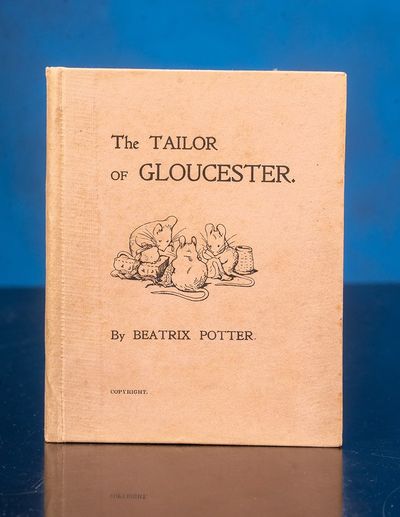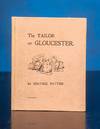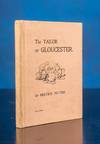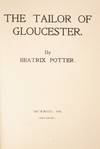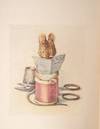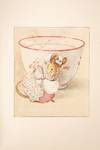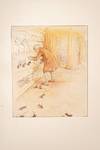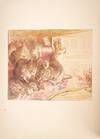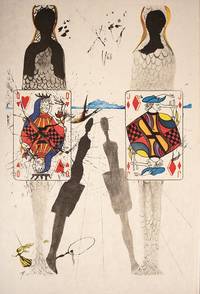first edition
by POTTER, Beatrix
London: Privately Printed by Strangeways and Sons, 1902. The First Privately Printed Edition
of Beatrix Potter’s Scarce Second Book
POTTER, Beatrix. The Tailor of Gloucester. [London: Privately Printed by Strangeways and Sons], December 1902.
First (privately printed) edition of Beatrix Potter’s scarce second book. One of 500 copies printed. Twelvemo (5 3/16 x 4 inches; 131 x 102 mm.). [96] pp. Color frontispiece and fifteen color plates.
Original pink boards pictorially stamped and lettered in black on front cover. A fine copy.
“Her privately printed edition of Peter Rabbit having enjoyed some success, Beatrix Potter decided to have this next work brought out in the same manner…It has a format similar to the privately printed Peter Rabbit, but with a binding of pink printed boards and a rounded back instead of a flat one. Miss Potter ordered 500 copies printed; they were ready by the middle of December 1902” (Morgan Library, Early Children’s Books).
The Tailor of Gloucester is a charming Christmas story written and illustrated by Beatrix Potter, and one she regarded as her personal favorite. The tale was inspired by a true incident from the 1890s involving a Gloucester tailor named John Prichard, whose assistants secretly finished a mayor’s ceremonial suit, leaving it nearly complete save for a single buttonhole and a note.
Set in 18th-century Gloucester, the story centers on a poor, elderly tailor who is commissioned to make a magnificent embroidered coat and waistcoat for the Mayor’s Christmas Day wedding. After cutting the fine cherry-colored silk, he realizes he is one skein of twist short. With no money left, he sends his cat, Simpkin, to buy more.
While Simpkin is away, the tailor discovers a group of mice trapped under teacups in his shop and kindly sets them free. Upon returning and finding his mice gone — along with his supper — Simpkin, in a fit of spite, hides the twist.
Falling ill and unable to complete his work, the tailor returns to his shop on Christmas Eve to find the coat miraculously finished — every buttonhole sewn except for one. A tiny note reads, “No more twist.” The tailor’s unknown helpers were the grateful mice, repaying his kindness.
Simpkin, softened by their good deed, retrieves the hidden twist, allowing the tailor to complete the coat in time. On Christmas morning, the Mayor is delighted with his beautiful garments, and the tailor’s reputation is secured, promising him a prosperous future.
Linder, p. 420. Morgan Library, Early Children’s Books, 221. Quinby 3. V & A 1562-1568. (Inventory #: 06241)
of Beatrix Potter’s Scarce Second Book
POTTER, Beatrix. The Tailor of Gloucester. [London: Privately Printed by Strangeways and Sons], December 1902.
First (privately printed) edition of Beatrix Potter’s scarce second book. One of 500 copies printed. Twelvemo (5 3/16 x 4 inches; 131 x 102 mm.). [96] pp. Color frontispiece and fifteen color plates.
Original pink boards pictorially stamped and lettered in black on front cover. A fine copy.
“Her privately printed edition of Peter Rabbit having enjoyed some success, Beatrix Potter decided to have this next work brought out in the same manner…It has a format similar to the privately printed Peter Rabbit, but with a binding of pink printed boards and a rounded back instead of a flat one. Miss Potter ordered 500 copies printed; they were ready by the middle of December 1902” (Morgan Library, Early Children’s Books).
The Tailor of Gloucester is a charming Christmas story written and illustrated by Beatrix Potter, and one she regarded as her personal favorite. The tale was inspired by a true incident from the 1890s involving a Gloucester tailor named John Prichard, whose assistants secretly finished a mayor’s ceremonial suit, leaving it nearly complete save for a single buttonhole and a note.
Set in 18th-century Gloucester, the story centers on a poor, elderly tailor who is commissioned to make a magnificent embroidered coat and waistcoat for the Mayor’s Christmas Day wedding. After cutting the fine cherry-colored silk, he realizes he is one skein of twist short. With no money left, he sends his cat, Simpkin, to buy more.
While Simpkin is away, the tailor discovers a group of mice trapped under teacups in his shop and kindly sets them free. Upon returning and finding his mice gone — along with his supper — Simpkin, in a fit of spite, hides the twist.
Falling ill and unable to complete his work, the tailor returns to his shop on Christmas Eve to find the coat miraculously finished — every buttonhole sewn except for one. A tiny note reads, “No more twist.” The tailor’s unknown helpers were the grateful mice, repaying his kindness.
Simpkin, softened by their good deed, retrieves the hidden twist, allowing the tailor to complete the coat in time. On Christmas morning, the Mayor is delighted with his beautiful garments, and the tailor’s reputation is secured, promising him a prosperous future.
Linder, p. 420. Morgan Library, Early Children’s Books, 221. Quinby 3. V & A 1562-1568. (Inventory #: 06241)
